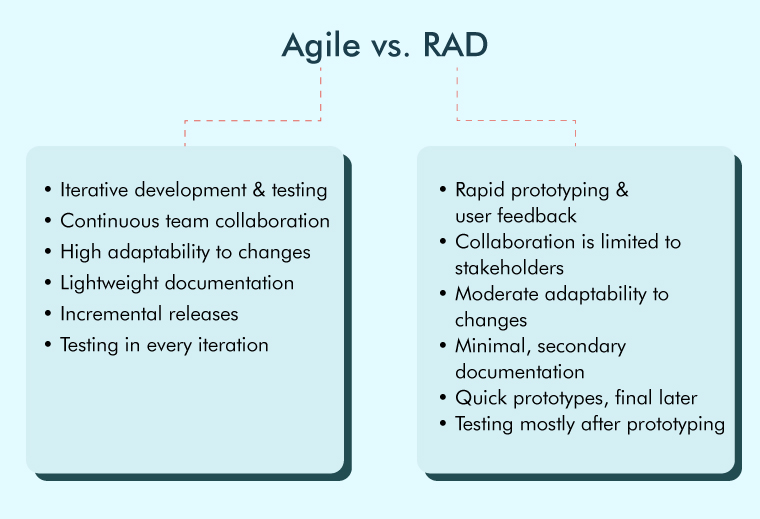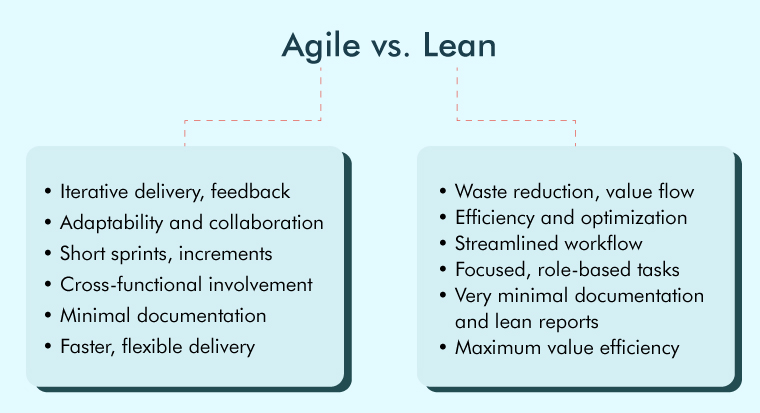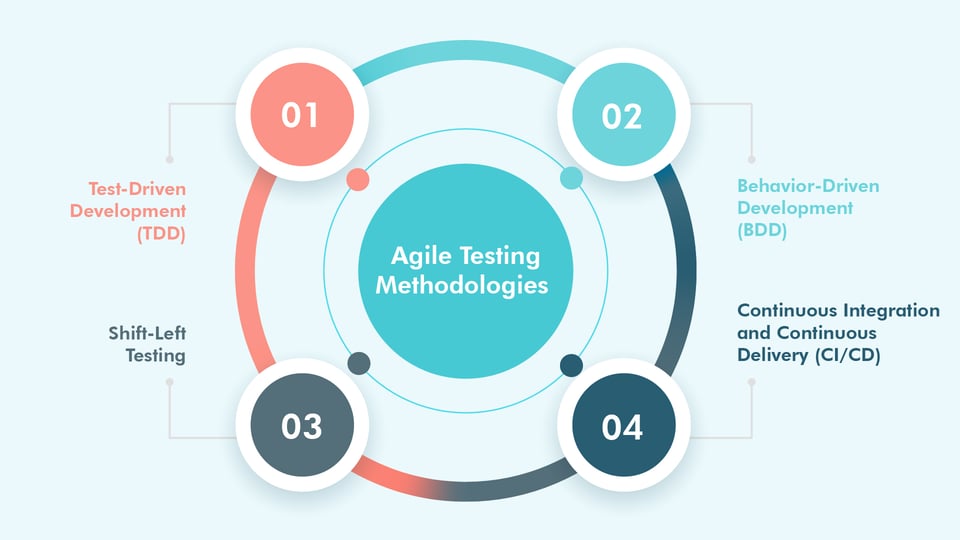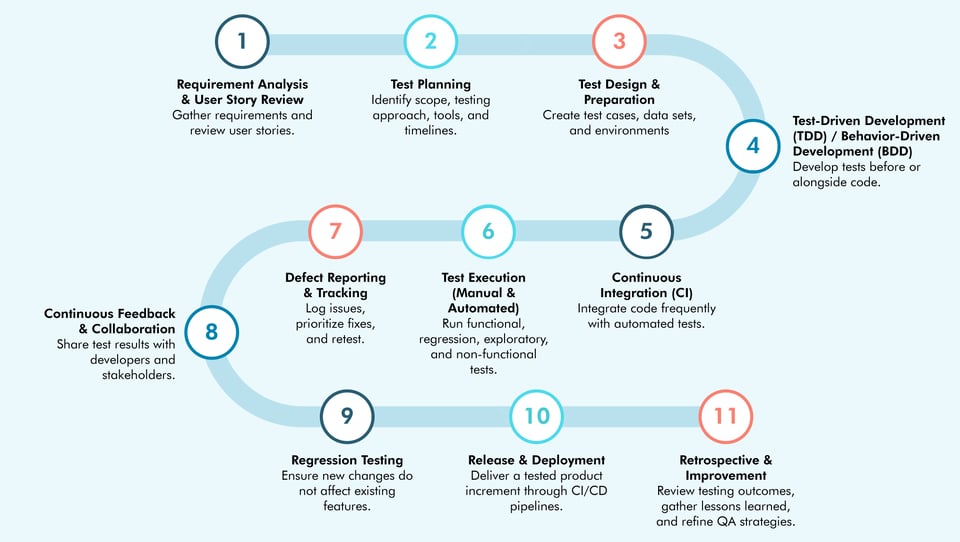
Learn how Agile testing services transform software testing with flexibility, collaboration, automation, and AI-powered trends. Our guide states processes, techniques, benefits, and offshore solutions for faster, high-quality releases.
Table Of Contents
- What is Agile testing?
- Key aspects of Agile testing services
- Agile vs. Waterfall
- Agile vs. RAD
- Agile vs. Lean
- Common methodologies used in Agile testing
- Agile testing: Step-by-step process
- Advantages of Agile QA testing
- Impact of agile QA testing on software methodology
- Tools used for Agile testing services
- Remote and offshore Agile testing services
- Switching over to Agile testing services
- Latest AI trends in Agile testing services
- Why Agile QA testing is the future?
Agile testing is your future. It will save you time. It will save you money. It will save you resources. The gold standard of QA methodologies, Agile testing and development, is designed to evolve with the product. The process aligns with the rapid growth of the software development market, which demands faster testing speeds and higher-quality products that deliver enhanced customer experiences.
Transparency and shared ownership bring teams together and speed up innovation. Over time, agile methodologies help build a culture where quality is not an afterthought but a core part of the development process.
Fact Check
71% of businesses now use Agile in their software development lifecycle (SDLC), a clear indicator that Agile has become mainstream in modern development practices. In practice, Agile testing services embed QA into the development cycle, enabling testers and developers to work side by side. In this blog, we’ll explore everything related to Agile testing and why it’s the best option for software development and QA teams currently.
What is Agile Testing?
Agile testing originated from the Agile Manifesto, which emphasized collaboration, adaptability, and delivering working software quickly. At its core, ‘test early, test often’ signifies that testing is embedded in every iteration, not treated as a separate stage of development. Teams get immediate feedback, issues are addressed as they arise, and the product evolves in sync with changing requirements.
Wherever practical, tests are executed through automation, user stories guide validation, and continuous integration ensures that every code change is verified in real-time. Compared to legacy models like the Waterfall method, Agile QA services eliminate the long gaps between development and testing. There are faster releases, reduced rework, and a smoother project flow, helping teams deliver high-quality products that truly meet user expectations.
Key Aspects of Agile Testing Services
Agile QA services are built on a set of core principles that ensure quality, adaptability, and efficiency throughout the software development lifecycle. By following these principles, teams ensure the delivery of reliable solutions aligned with the evolving demands of both organizations and end-users.
- Continuous Integration: Agile testing leverages continuous integration to merge code changes frequently and test them immediately. Testers identify issues early, maintain code stability, and reduce integration challenges, ultimately ensuring smoother and faster releases.
- Flexibility: Agile testing is built around flexibility, allowing teams to adapt to changing requirements without disrupting timelines. It supports iterative improvements, quick responses to feedback, and efficient adjustments to meet business and customer expectations.
- Collaboration: Agile testing services foster close collaboration between developers, testers, and stakeholders. The shared responsibility ensures clear communication, faster decision-making, and higher-quality deliverables that align with both technical standards and business objectives.
- Focus on Value: By prioritizing features and tests that deliver the highest value to the end user, Agile QA ensures resources are invested wisely. With this approach, teams can maximize ROI while keeping user satisfaction at the forefront.
- Diverse Testing Types: These services incorporate a variety of testing types, including functional, non-functional, automated, and exploratory testing, throughout the development cycle. Teams can ensure comprehensive coverage and help detect issues across all aspects of the product.
Agile vs. Waterfall
The advantages of Agile testing become apparent when you compare the methodology to the traditional Waterfall approach. The latter divides development phases into distinct and exclusive functions, almost creating competing interests within your product delivery.
For example, engineers may resist QA uncovering flaws in their work, while QA teams feel pressured to prove their worth by finding bugs. This division also makes it expensive and time-consuming to integrate corrections and improvements into the final product.
With the Waterfall methodology, development typically takes place over three months, followed by a three-month QA phase. One process does not begin until the other has reached a stopping point. But what if the QA team discovers a big bug toward the latter end of this collective process? The strategy is not well-suited to flexible troubleshooting, and the resulting delay could have serious repercussions.
With the Agile approach, teams are trading off development and testing. They are in a position to find bugs sooner and get software to market much sooner. Under this model, teams are set up for meaningful collaboration, effective communication, and proactive goal-setting.
Even when it means disrupting a legacy software development system already in place, making the change to Agile brings numerous benefits for both the immediate and long-term future. The practical implementation of the Agile methodology can yield real-world savings in resources, time, and money.

Agile vs. DevOps
DevOps brings together development, QA, and IT operations in an Agile relationship. It defines how these teams collaborate to achieve continuous integration, monitoring, and delivery. At its core, DevOps relies on fluid, constant communication among experts, forming the backbone of a flexible and highly productive environment.
Agile vs. Scrum
Scrum is one of the most popular frameworks that has evolved from the Agile process. It works on a series of relatively short sprints that take a product feature through the analysis, design, coding, testing cycle described above. Scrum teams are cross-functional experts that put Agile collaboration into practice.
Agile vs. RAD
Like Agile development, rapid application development, or RAD, aims to deliver software to the user as quickly as possible. It is an engineering methodology committed to flexibility and adaptability in software development.
Even more than the Agile methodology, RAD prioritizes early action and prototyping over planning, with the understanding that the best methods and product features will emerge during development cycles.
Whereas many Agile best practices are implemented from the very start of the development and testing cycles, RAD tends to be even more flexible, allowing for the development of a prototype as quickly as possible to facilitate feedback and change. Like Agile, RAD assumes that change is inevitable and actively responds to client or tester feedback, embracing revisions as needed.

Agile vs. Lean
While Agile emphasizes a collaborative approach to adaptability and software quality, Lean development focuses on the efficiency of the process itself. Lean streamlines processes by eliminating unnecessary steps, leaving only those that deliver clear value. Agile and Lean are not necessarily mutually exclusive methodologies.
Together, Agile and Lean principles expect uncertainties and adapt to product development and testing cycles. Lean and Agile both initiate important alternative principles to Waterfall-style project management. Both are cooperative approaches, but Agile tends to promote proactive planning and strategy. In contrast, Lean tends to promote reactive changes in development, waiting until the last moment in a cycle to minimize unnecessary effort and resource expenditure.

Common Methodologies Used in Agile Testing
Agile testing can be implemented through different methodologies, each designed to improve collaboration, speed, and product quality. They guide how testing is planned, executed, and integrated into the development cycle, ensuring continuous delivery of reliable software.

-
Test-Driven Development (TDD)
In TDD, tests are written before the actual code. Developers create small, testable units, write corresponding tests, and only then implement the code. Test-driven development ensures higher code quality, fewer defects, and easier maintenance throughout the Agile testing services process.
-
Behavior-Driven Development (BDD)
BDD focuses on defining application behavior through clear, business-readable scenarios before development begins. It bridges the gap between technical teams and stakeholders, ensuring Agile QA testing closely aligns with business requirements and user expectations.
-
Shift-Left Testing
Shift-left testing involves moving QA activities earlier in the development lifecycle. By identifying defects sooner, teams reduce rework, speed up delivery, and ensure higher-quality outcomes without disrupting the project’s flow or timelines.
-
Continuous Integration and Continuous Delivery (CI/CD)
CI/CD automates code integration, testing, and deployment, enabling fast, reliable releases. It supports Agile testing services by ensuring new features and fixes are validated and delivered to users quickly and consistently.
Agile Testing: Step-by-Step Process
Here’s a structured list of the main steps in the Agile testing process, starting from the beginning to the end of a project cycle:
- Requirement Analysis & User Story Review: Gather requirements and review user stories.
- Test Planning: Identify scope, testing approach, tools, and timelines.
- Test Design & Preparation: Create test cases, data sets, and environments.
- Test-Driven Development (TDD) / Behavior-Driven Development (BDD): Develop tests before or alongside code.
- Continuous Integration (CI): Integrate code frequently with automated tests.
- Test Execution (Manual & Automated): Run functional, regression, exploratory, and non-functional tests.
- Defect Reporting & Tracking: Log issues, prioritize fixes, and retest.
- Continuous Feedback & Collaboration: Share test results with developers and stakeholders.
- Regression Testing: Ensure new changes do not affect existing features.
- Release & Deployment: Deliver a tested product increment through CI/CD pipelines.
- Retrospective & Improvement: Review testing outcomes, gather lessons learned, and refine QA strategies.

Advantages of Agile QA Testing
Agile testing offers numerous advantages that go beyond faster delivery. They enhance product quality, improve team efficiency, and ensure software meets evolving user needs while reducing risks and development costs.
- Easy Workflows: Tight and easy workflows enable close collaboration among teams, as they can maintain a clear understanding of the project and requirements as a whole. Streamlined workflows provide teams with the flexibility to adapt quickly throughout testing and development.
- Continuous Improvement: Under Agile conditions, testing becomes more than just a search for bugs. Your QA experts’ understanding of your domain and the needs of your users can be incorporated into the cycle to improve your product at every iteration.
- Project Tracking: Breaking the project down into small sprints enables your team to deliver more effectively against the pressures of the release cycle. Bugs are easily identified and corrected, and improvements are made without grinding development to a halt.
- Faster Time to Market: Agile testing services streamline development cycles by integrating testing at every stage, enabling quicker issue resolution and accelerating release schedules without compromising product quality.
- Higher Quality Products: Agile QA testing ensures continuous feedback and improvement, allowing defects to be caught early and resolved promptly, resulting in more reliable, stable, and high-performing software.
- Reduced Costs: Agile testing reduces costly rework and budget risks by identifying and resolving issues early, while making better use of resources.
- Increased Team Morale: Collaborative workflows and shared ownership in Agile QA services promote trust, transparency, and a positive work environment, thereby boosting motivation and overall productivity.
- Improved Customer Satisfaction: Agile testing prioritizes user feedback, ensuring the final product meets expectations, performs flawlessly, and delivers a seamless experience that keeps customers engaged and loyal.
- Broader Coverage: Agile teams allow for the input of cross-functional talents to ensure the product is delivered against the highest business, technical, coding, and user expectations. One of the most significant advantages of the Agile approach is that it enables you to leverage remote and offshore QA opportunities more effectively.
Impact of Agile QA Testing on Software Methodology
Agile QA testing has reshaped traditional software development methodologies by embedding quality checks into every phase of the lifecycle. Instead of treating testing as a final step, it drives continuous improvement, faster delivery, and more reliable outcomes across projects.
- Quality and Team Involvement: Agile methodology is a widely used approach to software development that seeks to produce high-quality software quickly and effectively. Based on a set of guiding principles that emphasize adaptability, flexibility, and teamwork.
- Transparency and Strong Action for Major Stakeholders: The approach has a positive impact on meeting customer expectations by delivering software on time and responding promptly to changing requirements. Agile testing services encourage the end-user to participate actively in the project's direction and establish the proper expectations.
- Regular Retrospectives and Iterations: The agile methodology encourages holding regular retrospectives to identify and address any problems that develop in projects with a lot of unknowns (designs and functionality).
- Control Over Budget and Schedule: There are lower levels of misunderstanding and miscommunication and realistic expectations for delivery. Due to the constrained scope of work typically established within a given sprint in an agile setting, it is easier to provide clients accurate cost and timeline estimates.
Tools Used For Agile QA Testing
It is a popular tool used for Agile project management and also has powerful test management features.
It is a comprehensive web-based test case management software that helps you manage, track, and organize your testing efforts.
It is a popular test management tool that integrates with Jira and offers features such as test case management, test execution, and reporting.
This is a comprehensive test management tool that supports Agile and DevOps methodologies.
It is a web-based test management tool that offers features such as test case management, test execution, and reporting.
This tool is an agile test management tool that integrates with Jira and offers features such as test case management, test execution, and reporting.
(Quality Center)
It is a comprehensive test management tool that offers features such as test planning, test execution, and reporting.
It is a comprehensive test management tool that offers features such as test planning, test execution, and reporting.
Remote and Offshore Agile Testing Services
Our digital world has put us all in a position to communicate face-to-face, regardless of where geography separates us. Communication devices such as video conferencing, messaging, email, and workplace collaboration apps make meetings across city, state, and national boundaries effortless.
As a direct result, it has never been easier to incorporate the benefits of remote and offshore Agile QA testing. External QA experts can integrate into workflows and meetings just as smoothly as if they were working on-site. The communication challenges are comparable to those you would face in an internal setting, and you can maximize the Agile advantages by adding resource, time, and expertise efficiencies beyond your team’s capacity.
- Domain Expertise: Tap into industry experts who are familiar with the latest trends, tools, technologies, and security and regulatory demands specific to your domain.
- Resource Savings: Offshore and nearshore Agile QA testing services are significantly less expensive to train, maintain, and reuse compared to domestic sources. Outsourcing to India can reduce your QA costs by 50%.
- Rapid Scaling: Introducing an external QA provider enables you to rapidly scale up your output for targeted periods around your release cycle without incurring long-term human resource costs.
- Build Faster: QA experts know what they are doing. A skilled QA partner can ramp up swiftly and deliver tasks with efficiency. Additionally, they can introduce your internal team to best practices for documentation, reporting, and test production.
- Maximize Your Resources: By integrating a QA expert, you can free up your internal team to focus on their core duties. Reduce stress and workload on your creative and developmental minds without sacrificing speed and coverage.
- Create a 24-Hour Workflow: The time difference between the U.S. and popular QA locations, such as India, allows you to work around the clock. Your QA team can test overnight and prepare reports for your engineers to access in the morning.
The combined time and resource savings make it well worth considering a change in your approach to QA testing.
Switching Over to Agile Testing Services
Making the switch to an Agile environment is hard when you are used to a more sequential methodology. However, with experienced guides, it is possible to adapt quickly and benefit from Agile QA services. It begins with getting everyone in the same room. You have to break down the barriers of your existing culture and create a more collaborative environment.
To ease the transition, partner with a team of Agile experts. Agile Consultants quickly spot areas for change and seamlessly integrate into your testing and development team. We have included below a short list of best practices that help your team make the switch to Agile QA testing.
- Train on Agile Processes and Tools: Provide training to your engineers on Agile practices and terminology, such as Scrum, sprint tasks, and story points, to highlight the differences in the approach. Your team should also be exposed to Agile tools used to track progress, including how to handle time and how to mark sprints as complete.
- Standardize Documentation: You need to create standard templates that your team can use to document processes with precise, detailed information. Consistency is key to collaboration.
- Improve Communication: As with the use of standard documents, your team needs to learn efficient means of communication to create momentum. Use every technology available, from phone and email to video conferencing and chat messaging.
- Prioritize Tasks: Every member of the team should be aware of the importance and volume of each specific task and prioritize it accordingly. Related tasks should be grouped to aid efficient development.
- Share Information and Perspective: All Agile QA team members should stay updated on the project’s overall progress to ensure alignment and collaboration. It begins with cross-functional teams attending scoping plans and continues through the build with regular discussions and scheduled meetings.
Agile testing services require us to change the culture of our organizations. What we get in return is a more efficient and rewarding use of the talent and expertise that we have. Collaborative teams build better products. New Agile habits are within reach when you have QA expertise on your side.
Latest AI Trends in Agile Testing Services
The integration of AI into Agile QA services is transforming how teams approach quality assurance. By automating repetitive tasks, analyzing vast datasets, and predicting potential issues, AI enhances both speed and accuracy in Agile QA testing. Below are some of the latest AI-driven trends shaping the field:
- AI-powered Test Automation: AI tools can automatically generate, update, and execute test cases based on code changes or user stories. It reduces manual effort, speeds up validation, and ensures coverage for rapidly evolving software.
- Predictive Defect Analysis: Using historical defect data and code metrics, AI algorithms can predict high-risk areas in the application. Agile QA testing focuses on the most vulnerable components, improving defect detection rates.
- Intelligent Test Case Prioritization: AI can prioritize test execution based on business impact, recent changes, or historical failure patterns, ensuring critical functionalities are tested first and release cycles remain efficient.
- Self-Healing Test Scripts: With AI, automated scripts can adapt to UI or API changes without human intervention, reducing test maintenance time and keeping pace with Agile development speed.
- Natural Language Test Creation: Testers can now use plain English to create automated tests, enabling faster onboarding, reducing technical barriers, and encouraging more team members to contribute to the testing process.
Why Agile QA Testing Is The Future?
Agile QA services are the future of product development. With the right experts on board, your team can produce better products faster by working within a continuous, evolving, and collaborative environment. It is a logical extension of the development and testing processes where the talents that built the product and the QA testers who know how to realize its potential work together.
QASource has a proven track record of creating and leading Agile teams. Our engineers have over 1,000 years of collective software testing experience, which enables us to reduce training costs and delays, and scale your services immediately as needed.
With an international presence on three continents and access to the latest tools and technologies, we can become a valued part of your product development team. Contact us today for a free quote and get started.


